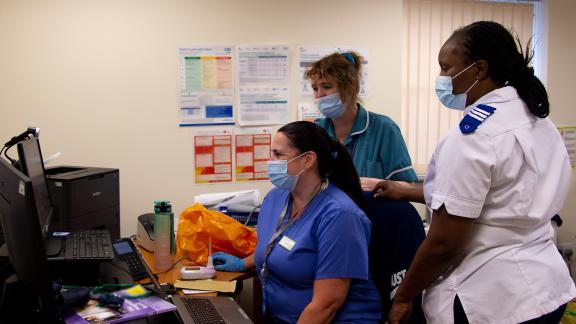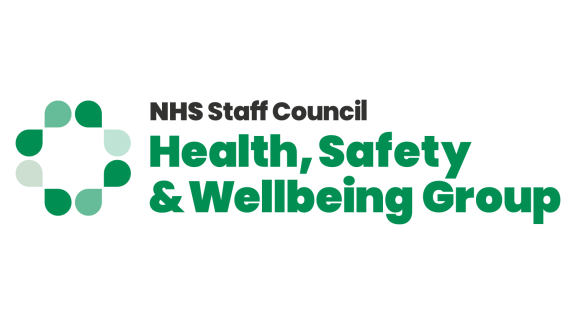
The Long Term Workforce Plan emphasised the importance of retaining our valued NHS workforce. Employers should be looking at their wellbeing offer and critically evaluating the experience of staff through all stages of their careers.
A positive staff experience and a rounded support offer are vital to encouraging staff to remain in the workplace. Our guide provides practical tools that will help NHS health and wellbeing and staff experience leads deliver successful communications campaigns and initiatives to support their colleagues.
Initial considerations
- Download this chapter
- Initial considerations
Your communications and engagement plan
For your health and wellbeing strategy or initiative to be a success, it’s essential that you follow these ten key communications steps:
- Meet with key stakeholders and communications colleagues to discuss your plans and seek their advice, support, ideas and expertise.
- Develop your key messages and share them with all colleagues involved.
- Identify your target audience and decide on the channels that will be most effective to reach them.
- Allocate resources and budget (if you have one).
- Plan your events and activities. If you’re using social media, draw up a strategy.
- Identify potential media opportunities.
- Decide how you will launch your campaign or initiative.
- Monitor the campaign regularly to help you produce an accurate evaluation report.
- Produce an overall evaluation, identifying what worked well and what could be improved.
- Start planning the next phase, repeating these steps.
Getting started

When you meet with key stakeholders, it’s useful to have already drafted a plan to help discussions. The communications stages will help you to shape your plan by identifying areas you should try to cover, including:
- Objectives - For example, to promote smoking cessation to nursing staff and reduce the number of smokers by five per cent by April 2023.
- Key message(s) - Smoking is bad for your health, benefits of quitting, ways you can stop and how the trust can help staff.
- Target audience - Nurses across the trust.
- Activities - Create a video of a senior member of nursing staff talking about the benefits of quitting smoking.
- Timings - Throughout September in line with the upcoming Stoptober campaign.
- Communication channels - Intranet to host the video, posters in staff rooms and in smoking shelters, line managers to talk directly to their team.
- Evaluation - Pre and post campaign surveys using SurveyMonkey and face-to-face feedback.
Our eight elements to a positive staff experience resource includes details and information that are essential for creating, implementing and evaluating an effective staff experience strategy.
- Download this chapter
- Your communications and engagement plan
Stakeholder engagement and collaborative working
Before you deliver your campaign or initiative, it's essential that you engage with key stakeholders (those who can help you drive your messages/campaign forward) and teams. Working collaboratively will help to ensure that your campaign or initiative is a success.
Get your leaders onboard
Some campaigns or initiatives may benefit from buy-in from your senior leadership team. Encourage your leaders to echo the importance of your messages. Showcasing in your communications how leaders embrace and use the available wellbeing initiatives, can encourage staff to engage in them.
Collaborate with your communications team
It is important to involve your communications colleagues at the outset so that they can factor your plans within the overall organisation-wide communications strategy. Communications colleagues will be able to advise you on matters such as:
- best channels to use
- media opportunities (if applicable)
- messaging including style and tone
- when will be the best time to launch your activities for maximum impact.
Before approaching your communications and/or HR team, you should:
- complete the communications plan and share this plan with the team. This will help to ensure their buy-in and check your plans do not overlap with anything they are planning to do
- finalise your key messages as much as possible before sending them for review
- have a clear plan of timescales and what actions you require from the team
- think about the evaluation of the campaign, do you need any input from the communications team?
- share any evaluation of previous similar activities to demonstrate the effectiveness of the initiative
- find out if there are any national campaigns that you can use as a hook for your campaign or initiative.
Questions you might want to ask your communications team
- Is there a monthly or annual communications plan so you can check that your messages won’t conflict with any organisation-wide campaigns?
- Does you organisation have any plans for upcoming national awareness days/weeks/months that would be good to link your campaign to, for example Stress Awareness Week.
- What channels are available for you to communicate with staff? Ask your communications team if they can share copy deadlines and publication dates with you.
- What other resources are available to you, for example an onsite photographer or designer.
- Check what your house style is, for example the font you should use, branding etc.
- Check if there are any guidelines regarding the use of social media.
- Download this chapter
- Stakeholder engagement and collaborative working
Engaging your audience with effective messaging
Clear, simple, honest messaging works. It is important that your strategy is respected, and people are most likely to respect information that is well presented, easy to understand and is without any spelling or grammatical errors.
Keep it short and simple - Using simple language and keeping your sentences short and punchy will help people in your organisation to digest information easily. Avoid jargon where possible and always remember that you’re writing for your reader, not for yourself. So, get creative, be original and think about ways in which your messages can stand out from the crowd.
Use facts, figures and statistics - Think about how you can incorporate figures and statistics into your messaging, as they are an effective way of getting the reader’s attention. It is beneficial to use localised data to make your messages relevant to your audience. Modifying your communications can engage those who are hard to reach in any particular group. Find out what local data is available to you to make your messages more interesting to your audience. For example, you could use the exact amount of stairs in your organisation and how many calories they would burn walking up rather than getting the lift.
Use personal stories - Asking for quotes and testimonials to use on materials is a good way of allowing your audience to see how the health and wellbeing initiative have impacted on other people. It is often the personal stories that help people to understand the benefits of a programme.
Further reading
- Using technology to communicate your reward offer these examples give you a snapshot of how some NHS organisations are using technology to make staff aware of their reward and benefits.
- Improving deaf awareness in the workplace - Sam Penney is a staff nurse with severe hearing loss. Sam shares some of the challenges she has faced and encourages everyone to be more deaf aware.
- Seven suggestions for sustaining engagement in tough times: we've captured top tips from some of the best performing organisations in the 2021 NHS Staff Survey.
- NHS staff wellbeing needs poster - This resource highlights the importance of basic needs to help ensure our NHS people feel healthy at work.
- Download this chapter
- Engaging your audience with effective messaging
Resources and budget
Your trust may or may not have a dedicated budget for health and wellbeing communications, it is important nevertheless to use your existing resources effectively. Below are some tips and hints for you to consider:
- Use your health and wellbeing champions or clinical champions effectively, especially when reaching busy frontline staff. Build in regular time to inform them of upcoming initiatives and to share ideas on effectively engaging staff. Read our guide on how you can introduce wellbeing champions into your trust.
- Use existing channels where possible. For example, attending some staff network meetings (such as disability or BME networks) allows you to reach these audiences and spark further conversation with staff. Listen to how staff networks can support the health and wellbeing of staff in our webinar recording.
- Consider what funding your trust can provide (if any). Are you able to put in a bid to your trust’s charity? Using evidence from previous evaluations will support your bid.
Further reading
A collaborative approach to delivering a staff benefits portal - South West London acute provider collaborative has delivered a single contract staff benefits portal with four South West London NHS trusts.
- Download this chapter
- Resources and budget
Your audience
It's essential that you define your target audience and think about the best channels and timings to communicate with them. You should also:
- decide which staff groups you need to engage with and why
- consider if the information is applicable to all staff
- consider the demographics in your organisation. Understanding this data, and how it may impact preferences in communication style
- use clear, simple, and honest messaging
- use simple language and keeping your sentences short and punchy will help people in your organisation to digest information easily
- keep an open mind when engaging your audience, considering that perhaps not everyone is eager to be reached or to take part. Listening to what staff want and need can help you communicate the right message to the right people, at the right time
- consider how will you engage your hard-to-reach staff members. This includes busy frontline staff who may not have time to access emails or attend events.
- ensure your messages are inclusive. Visit our equality, diversity and inclusion web pages to read more about how you can implement inclusive practices into your strategy.
Through building strong connections across the organisation, you can spread the message more effectively, engage your audience in sharing your content and encourage them to get involved. It can also raise your profile, and foster trusting relationships where staff feel able to approach you.
Other opportunities to get buy-in include:
- reaching out to managers and ask them if you can attend team meetings to introduce yourself and highlight key initiatives. Actively reaching out to staff is more effective than expecting them to come to you for information. Ensure staff know who you are, where to find you, and create a safe environment to for them to be open and honest
- see if you can introduce yourself and share details of local initiatives, for example during new staff inductions
- network and collaborate externally too. Building strong connections with charities to support you campaigns or initiatives can strengthen your general wellbeing offer.
Our supporting line managers to communicate the reward offering is a template that can use to summarise and communicate your reward package.
Twelve top tips on staff engagement is a collection of top tips from the organisations that saw the most improvement on the NHS Staff Survey.
Use facts, figures and statistics
Think about how you can incorporate figures and statistics into your messaging, as they are an effective way of getting the reader’s attention. It is beneficial to use localised data to make your messages relevant to your audience.
Modifying your communications can engage those who are hard to reach in any particular group. Take a look at our article which offers high-level analysis from the results. You can find more detailed information from NHS England.
Find out what local data is available to you to make your messages more interesting to your audience. For example, could you use the exact amount of stairs in your organisation and how many calories they would burn walking up them rather than getting the lift to nudge people into making positive choices?
Understanding intersectionality and engaging with diverse staff and communities - As part of Equality, Diversity and Human Rights Week, Dr Shamaila Anwar talks about intersectionality and creating psychological safety.
A guide to improving staff disability data - This guide will help employers improve their staff disability data by using the recruitment process, manager engagement and data collection.
Good practice examples
- Newcastle upon Tyne Hospital Foundation Trust acted on feedback from a staff member on a digital resource that was not legible for colour blind staff. They immediately acted to adjust the colours to ensure accessibility and took the learning point for future resources.
- Newcastle Upon Tyne Hospitals NHS Foundation Trust also rolled out a staff survey to explore what staff want in reality, which informed their approach and shaped their communications strategy. They found that most staff preferred flyers and key dates visible on the notice boards and in the toilet facilities as opposed to emails about wellbeing, as people don’t have time to access information online. The survey also indicated that Band 6 and above staff often prefer emails whereas lower bands do not.
- Read how London Northwest University Hospital Healthcare NHS Trust implemented wellbeing rounds for the hard-to-reach wards as a way of communicating their health and wellbeing offer.
- Download this chapter
- Your audience
Behaviour change
Health and wellbeing programmes and/or initiatives often aim to encourage healthy behaviours in staff and to change unhealthy habits. All these ensure that staff are supported to stay healthy at work so they can thrive to be the best they can be.
This simple, memorable framework, developed by the Behavioural Insights Team, called EAST (Easy, Attractive, Social and Timely) can help you plan and implement your communications plan, to make sure it has the maximum impact.
Easy - when planning your campaign/intervention, make it as easy as possible for your staff to get involved by:
- minimising hassle
- keeping your messages simple.
Attractive - making something attractive is about both drawing attention to it, and making the action more appealing:
- highlight benefits of an action
- use rewards to attract people to take part.
Social - we are social beings and are heavily influenced by what those around us do and say. When we tell someone else we are going to do something, we are much more likely to see it through. Make your campaign social:
- show that most people perform the desired behaviour
- use the power of networks
- encourage people to make a commitment to others.
Timely - we are much more likely to respond to something if it comes at a convenient time and are more likely to change our habits during times of transition:
- prompt people when they are likely to be most receptive
- consider the immediate costs and benefits
- link into wider national events like National Walking Month or link your campaign/intervention with changing seasons.
- Download this chapter
- Behaviour change
Your channels
When starting a new campaign or initiative, you will need to think about which communications channels to use. The key consideration is what will be the most effective way to reach your target audience.
Using existing channels will save you time and effort, but may not always be appropriate or may need something in addition. So you may need to have a mix of existing and new channels, depending on available resources. It’s also important to have one place where all the information is held, this could be on an intranet or internet site.
It might be helpful to ask staff how they prefer to be communicated with. Do they have access and time to read emails? Would they prefer more traditional forms of communication such as posters? You can use this information to provide targeted communications to staff.
Things to think about when choosing your communication channels:
- How many staff are you targeting with the campaign or initiative? Where are they based, at one or many sites?
- Does your target audience work remotely? Can they regularly check emails or access the intranet?
- Could you collect quotes and testimonials from your staff which is a good way of allowing your audience to see how the initiative/campaign has impacted on other people. It is often the personal stories that help people to understand the benefits of a programme.
- Find people in your organisation to be the face of your campaign/initiative and tell their story as a great way to engage your audience. Could they write a blog to keep people informed of how the campaign or initiative is going.
- Would posters or payslip leaflets be a good way of reaching your audience? We’ve developed a suite poster and leaflet templates to get you started (see below) but remember to consider the ease of updating printed documents as opposed to digital ones, and any associated costs.
- Would sending a letter be a better way of communicating?
- What is your organisation’s policy on the use of social media? Could you use Twitter, YouTube, Facebook etc to communicate with staff?
- How can staff communicate with you and provide you with feedback?
- Could you set up an inbox for enquiries?
- Can you use line managers to communicate key messages, for example, give them a briefing to use at team meetings?
Top tip - Always remember to present your messaging in a positive way and use a call to action, such as ‘download’, ‘read’, ‘take part’ or ‘watch’.
Further resources - poster templates
We have produced a suite of free templates to help you promote your organisation's wellbeing offer through bespoke posters and leaflets.
The picture icons can be used to highlight the specific elements of your offer and you can add your organisation's logo and other details.
All the images and posters are available in colour and black and white options:
Good practice examples
- Read how Yorkshire Ambulance Trust adapted its communication strategy to reach a wider audience.
- The Leeds Teaching Hospitals NHS Trust uses a number of ways to promote health and wellbeing communications. They developed a Health and Wellbeing Roadmap that can be put on notice boards, walls or on the back of toilet doors. It includes a variety of QR codes to give staff easy access to health and wellbeing information. They also use stands that are taken on site so staff can talk to the health and wellbeing team directly. Other channels include the use of small cards that staff can discreetly put into pockets that contains financial wellbeing advice and links to resources.
- Royal National Orthopaedic Hospital NHS Trust uses the full capacity of MS Teams to create their wellbeing channel. This means that everything wellbeing related is easy to access and all in one place. The health and wellbeing team post weekly messages for staff, which can be 'liked' and commented on creating an interactive space. They have also built a website within the MS Teams channel which hosts a variety of information, including how to seek support around financial well-being, family issues, mental and physical health. The messaging is updated according to current staff needs.
- Oxford University Hospitals NHS Foundation Trust has four main hospital sites so they use a range of channels to ensure their wellbeing message reaches as many staff as possible. Their communications team send out twice-weekly staff bulletins which the wellbeing team uses to share key wellbeing events and initiatives. The messages are also shared on social media as well as on digital displays and physical posters across sites. A monthly all-staff briefing with the chief executive and the executive team also has a regular focus on wellbeing. Weekly wellbeing champion emails give an overview of all key wellbeing activity and the fortnightly forums for them also provide Q&A sessions. As part of their 'Engagement Promise' the wellbeing team run a series of 30-minute wellbeing webinars for staff and leadership teams and provide PowerPoint slides and PDFs with all the key information, so that information can be cascaded onwards to teams.
- Sheffield Teaching Hospitals NHS Foundation Trust's health and wellbeing offer is cascaded to staff through a multi-channel approach. Information is shared via the weekly trust communications bulletin and via the staff engagement and wellbeing team monthly newsletter. With the help of over 100 wellbeing champions, they display posters throughout the trust and the champions also share information verbally at team meetings. The trust has a very comprehensive health wellbeing SharePoint site which can be also be accessed by staff from home. They also have their own wellbeing twitter account to share information with staff via social media. More recently the trust established Microsoft teams channels for their carers forum, menopause advocates and long COVID support group and the wellbeing champions use this to promote further sharing of relevant wellbeing information.
Further resources
- Live tweeting from Bolton's emergency department - Read how Bolton NHS Foundation Trust used Twitter to share what was happening in its emergency department.
- Promotion, praise and promise - Find out how West London NHS Trust reduced attrition and improved staff engagement with its new initiative that congratulates staff promotions.
- The Big Thank You at King's College Hospital NHS Foundation Trust - Read how extensive staff engagement formed the basis of an award-winning recruitment campaign.
- Download this chapter
- Your channels
Timescales
Looking ahead and having an idea of what you would like to deliver as far ahead as possible allows you to remain in control and helps your communications team anticipate and support upcoming work. You should:
- build your timeline, starting with the delivery date and working backwards. This will help ensure you have considered the time and resources you need in each step of the process. What are your deliverables and timescales? Think about any upcoming health and wellbeing initiatives, awareness days and events that are already on your radar
- consider the timing of your communications and how much support you will need for each initiative. For an event, ensure you factor in the communications for the build-up, during and after the event. Post event communications can help ensure it remains in the spotlight and to encourage staff to engage in future events
- ensure you build in flexibility into your plan. This is especially useful in the ever-changing climate and with the unpredictable nature of the COVID-19 pandemic and workforce issues
- build some contingency into your timeline to handle any unexpected issues.
- Download this chapter
- Timescales
Evaluation
Evaluating is important so that you know what works, what doesn’t work and why. Your evaluation should be built into your planning from the very start and form the backbone of all future activities, and initiatives.
Here are some useful ways to plan your evaluation. Being able to evidence your results allows you to determine if the initiative or campaign was successful and if not, why not. Your evaluation should align with your aims and objectives. When thinking about your evaluation, you could consider:
- what is the health and wellbeing campaign or initiative aiming to achieve? What does success look like for you?
- whose behaviour is the campaign or initiative intended to change? Who will you need to engage with to collect statistics or feedback to inform your evaluation?
- what time period do you need to measure impact over?
- identifying performance measures you will use for each activity. You could use these to assess performance against programme objectives, such as:
- the number/type of activities carried out
- the impact on audience awareness, understanding and intention
- the numbers engaged in or exposed to the initiative
- action taken or changed behaviour as a result of being involved in the initiative
- review performance measures to see if you have, or are able to gather, benchmarking data.
Tools for evaluating
- Measure attendance at events – what proportion of staff did you reach? What was the engagement like? What feedback did you receive on the day?
- Obtain digital statistics - how many people read the article on the intranet? Find out who collates intranet web data to find out what statistics are available. It’s a good idea to find out a baseline of data – what was traffic like before the initiative compared to after?
- Get social media statistics – have you had an increase in followers? How many people used your hashtag, or signed up for your event? Using twitter analytics, for example can be helpful when gathering data.
- Surveys – whilst it may feel like survey fatigue, consider carrying out surveys before, during and after the campaign/initiative. They can either be done online (using a tool such as SurveyMonkey) or face to face – it often helps to add an incentive for people to complete surveys.
Effectively analysing your results allows you to assess whether or not the project was a success and whether something should be repeated to feed back to your board/senior management.
Top tip: take a look at the infographics published on our website for inspiration on how to present information on your findings/results.
Further reading
- Enhancing the attraction, recruitment and support experience for new healthcare support workers - Analysis of NHS Employers' second healthcare support workers survey covering trusts in Yorkshire and the Northeast.
- Download this chapter
- Evaluation
Tops tips

- Define your objectives as early as possible.
- Consider your target audience and define how they prefer to be communicated with and when.
- Be clear about what you want to communicate.
- See if there are other activities that are taking place within the organisation and use these platforms to communicate/reinforce your messages.
- Consider which channels would work best to deliver your campaign or initiative and if there are opportunities to reinforce messages using multiple channels.
- Use simple language and avoid using jargon and abbreviations.
- Use images on social media. Tweets with images tend to get better engagement.
- Clearly define how you will measure the impact of your campaign or initiative.
There are many ways to communicate and the factors that lead to you deciding which routes to take will depend on budget, resources, time and audience.
Identifying your audience will help you tailor your activity, construct effective and relevant messaging and choose appropriate communications channels. When you’re up and running, it is important to know how successful your campaign or initiative is. You don’t have to wait until it’s all over before making any tweaks or changes to improve your initiative. Measure, evaluate and adjust.
Finally, remember that ultimately your activity is about encouraging behaviour change – and the EAST tips (see the behaviour change section) are key to success.
Further resources
- Communications guide for reward - Download our reward communications guide to help you plan and communicate the reward package your organisation offers to staff.
- Communicating reward - This infographic shows the channels you could use to promote your reward package and reach as many staff as possible.
- Reward strategy toolkit - Use this toolkit to develop a successful reward strategy for your organisation.
- Mental wellbeing in the workplace infographic - Statistics and key facts on employee mental wellbeing in the workplace.
- Back to basics for a healthy working environment infographic - Statistics and key facts about the impact of hydration, nutrition, sleep, and regular breaks on workforce wellbeing.
- Download this chapter
- Tops tips



